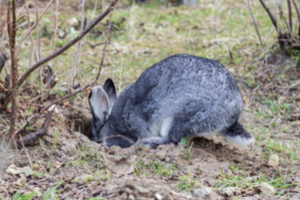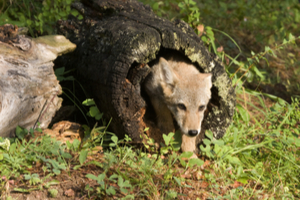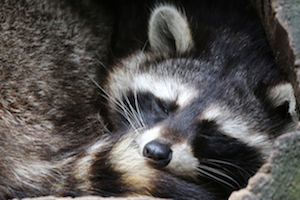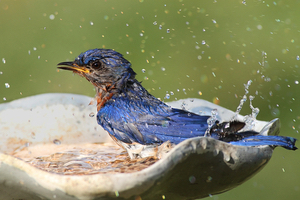Digging
 Several varieties of animals acclimate to heat by literally digging in. Animals that naturally burrow, like moles, voles, or gophers, generally stay put in their underground burrows during hot days. Skunks make burrows by digging under existing structures like porches and decks. On very hot days, they might hunker down inside their burrows until evening. Even animals without much digging capability like snakes might cover themselves in layers of topsoil to keep out of the sun.
It’s not hard to understand why animals dig to get out of the sun. The deeper they dig, the cooler they can remain. Some animals like moles may even build deeper or lower tunnels specifically to inhabit on very hot days. The animals simply remain underground until evening or night, and then hunt until it gets hot again. Mostly, burrowers keep to themselves, but they could still occasionally bother you. Skunks tend to burrow in shady areas near residences, for instance. If they’re around when you pass near their burrow, they may react defensively if you surprise them.
Several varieties of animals acclimate to heat by literally digging in. Animals that naturally burrow, like moles, voles, or gophers, generally stay put in their underground burrows during hot days. Skunks make burrows by digging under existing structures like porches and decks. On very hot days, they might hunker down inside their burrows until evening. Even animals without much digging capability like snakes might cover themselves in layers of topsoil to keep out of the sun.
It’s not hard to understand why animals dig to get out of the sun. The deeper they dig, the cooler they can remain. Some animals like moles may even build deeper or lower tunnels specifically to inhabit on very hot days. The animals simply remain underground until evening or night, and then hunt until it gets hot again. Mostly, burrowers keep to themselves, but they could still occasionally bother you. Skunks tend to burrow in shady areas near residences, for instance. If they’re around when you pass near their burrow, they may react defensively if you surprise them.
Hiding
 Not all animals are fortunate enough to be able to dig their way out of the heat. Those animals have to hide to stay cool--and often to survive! Cold-blooded animals like snakes, lizards, turtles, and frogs won’t last more than a couple hours in the hot summer sun. They need to find shade and shelter in order to regulate their internal body temperature. Warm-blooded animals need to stay out of the sun, too, or they could succumb to heat stroke.
A wide variety of common neighborhood wildlife hide out on hot days. Rodents, opossums, coyotes, and chipmunks all seek out shade and seclusion when it gets too hot. Common hiding places include nooks in trees, high branches, foliage, old animal burrows, and, unfortunately, human structures. It’s not uncommon for animals to sneak into human areas looking for a place to stay cool. This is especially likely if the structure is dark, quiet, and seems abandoned.
Not all animals are fortunate enough to be able to dig their way out of the heat. Those animals have to hide to stay cool--and often to survive! Cold-blooded animals like snakes, lizards, turtles, and frogs won’t last more than a couple hours in the hot summer sun. They need to find shade and shelter in order to regulate their internal body temperature. Warm-blooded animals need to stay out of the sun, too, or they could succumb to heat stroke.
A wide variety of common neighborhood wildlife hide out on hot days. Rodents, opossums, coyotes, and chipmunks all seek out shade and seclusion when it gets too hot. Common hiding places include nooks in trees, high branches, foliage, old animal burrows, and, unfortunately, human structures. It’s not uncommon for animals to sneak into human areas looking for a place to stay cool. This is especially likely if the structure is dark, quiet, and seems abandoned.
Sleeping
 Many cold-blooded animals enter a state of extended dormancy called “estivation” during particularly hot times of year. Estivation works like the inverse of hibernation. The animal finds a den to rest in and enters a deep “sleep”, or torpor. Like hibernation, this resting state lowers their metabolic rate and allows them to survive without food or water for extended periods of time. Where hibernation keeps an animal warm, however, estivation actually helps keep their bodies cool.
Estivation is practiced primarily by cold-blooded animals, but a few mammals enter it, too. Even if mammals don’t quite go dormant, they might sleep as a response to severe heat. Nocturnal foragers may sleep during hot days and stay out later at night to make up for lost time. Some animals, such as raccoons or opossums may attempt to find manmade structures to hide in while they sleep. Like burrowers, these animals may react defensively if you startle them or they feel threatened.
Many cold-blooded animals enter a state of extended dormancy called “estivation” during particularly hot times of year. Estivation works like the inverse of hibernation. The animal finds a den to rest in and enters a deep “sleep”, or torpor. Like hibernation, this resting state lowers their metabolic rate and allows them to survive without food or water for extended periods of time. Where hibernation keeps an animal warm, however, estivation actually helps keep their bodies cool.
Estivation is practiced primarily by cold-blooded animals, but a few mammals enter it, too. Even if mammals don’t quite go dormant, they might sleep as a response to severe heat. Nocturnal foragers may sleep during hot days and stay out later at night to make up for lost time. Some animals, such as raccoons or opossums may attempt to find manmade structures to hide in while they sleep. Like burrowers, these animals may react defensively if you startle them or they feel threatened.
Bathing
 Water is always an important consideration for wildlife, but it becomes priority number one on hot days. Not only do animals need more hydration than usual in summer time, water can also lower their body temperature. Birds often bathe themselves by washing their wings and feathers in water basins during hot days. Amphibians like frogs, toads, and salamanders need water to keep their bodies from drying out and cracking. Even mammals will use water to wet their fur and keep cool.
Obviously, animals prefer pools of open water on hot days, but they’ll settle for less. If you have faucet leaks, wet spots, or even condensation on your property, it could attract thirsty wildlife. Depending on where the moisture is, animals may infiltrate your home to get at it. If they can keep cool in shade at the same time, so much the better. Animals are particularly prone to approach homes near lakes and streams, particularly if there’s also nearby cover.
Adapting to summer’s heat is a process for everyone, and animals are no exception. Uncommon though it may be, animals may bother you in their attempt to acclimate to the heat. It’s hard to blame them, but that doesn’t mean you have to let it happen.
Instead, give Varment Guard a call any time. Our professionals can help solve your problem as humanely and effectively as possible.
Water is always an important consideration for wildlife, but it becomes priority number one on hot days. Not only do animals need more hydration than usual in summer time, water can also lower their body temperature. Birds often bathe themselves by washing their wings and feathers in water basins during hot days. Amphibians like frogs, toads, and salamanders need water to keep their bodies from drying out and cracking. Even mammals will use water to wet their fur and keep cool.
Obviously, animals prefer pools of open water on hot days, but they’ll settle for less. If you have faucet leaks, wet spots, or even condensation on your property, it could attract thirsty wildlife. Depending on where the moisture is, animals may infiltrate your home to get at it. If they can keep cool in shade at the same time, so much the better. Animals are particularly prone to approach homes near lakes and streams, particularly if there’s also nearby cover.
Adapting to summer’s heat is a process for everyone, and animals are no exception. Uncommon though it may be, animals may bother you in their attempt to acclimate to the heat. It’s hard to blame them, but that doesn’t mean you have to let it happen.
Instead, give Varment Guard a call any time. Our professionals can help solve your problem as humanely and effectively as possible.






